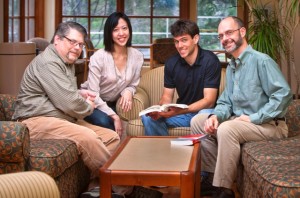By Michele Tallarita ’12

From left are Jeff Pfaffmann, associate professor and head of computer science; Joyce Laura Wong Hon Chan ’12; Nick Orzol ’13; and Chris Ruebeck, associate professor of economics.
As an electrical and computer engineering major, Nick Orzol ’13 (Mercerville, N.J.) is used to toying with circuits, computers, and other electronics.
For one of his projects this semester, however, his biggest concern is the wooden pallets used in shipping. Orzol is involved in interdisciplinary research that combines aspects of economics, computer science, and engineering to enhance environmental policymaking.
The project, which began in 2007 with a $635,000 grant from the National Science Foundation, has combined the efforts of students from many different majors over several years. The team has recently included, in addition to Orzol, computer science majors Shannon Sullivan ’13 (Short Hills, N.J.) and Christopher Jones ’13 (Macungie, Pa.); Timothy Johns ’13, another electrical and computer engineering major; Kelsey Lantz ’13 (Washington, Pa.), a double major in international affairs and engineering studies; Joyce Laura Wong Hon Chan ’12 (Tombeau Bay, Mauritius), a double major in economics and math; and Phuong Anh Nguyen ’12 (Ho Chi Minh City, Vietnam), an international economics and commerce major. The work is led by Jeff Pfaffmann, associate professor and head of computer science; Chris Ruebeck, associate professor of economics; and Kristen Sanford Bernhardt, associate professor of civil and environmental engineering and chair of the engineering studies program.
Over the years, the team has focused its research on using computational models to simulate the life cycles of wooden shipping pallets, cell phones, and water systems. The research is built on a decision-making model (developed by Pfaffmann, Ruebeck, and Sharon Jones, former professor of civil and environmental engineering) that combines economic incentives with environmental data to predict market participants’ interactions and understand their environmental impact. Using computer simulations running on advanced parallel-processing computing equipment, the team continuously improves the models and uses them to test case studies.
Crafting these models is extremely challenging because there are many different factors involved in making decisions.
“In some sense, we’re attempting to do what realist artists attempted,” Pfaffmann says. “We are trying to paint a picture of the product life cycle, and how it influences people’s behavior and the environment. It’s a very complex problem because this is inherently a creative act, and you don’t initially know if your predictions will be correct. But then to make that picture accurate, you need to validate what the model is doing, which might involve changes to the model.”
“Students come to understand the open-ended nature of the research process, and the process by which we focus our ideas to a workable output goal,” says Ruebeck. “They explore new ideas and learn new skills.”
The project gave Wong Hon Chan, who worked on applying the pallet model to grocery retailers in the Lehigh Valley, a strong foundation for her senior honors thesis, which uses the same modeling techniques to explore the decision-making behaviors of cell phone users and retailers.
“Merging computer science with economics has enabled me to be much more creative in terms of what I can potentially study,” she says.
Orzol’s biggest job is running the model that simulates how the wooden pallets used to ship goods bounce between manufacturers, retailers, and repair firms. Although running models on computers lies within Orzol’s comfort zone, the project adds the dimensions of economics and the environment. Often, he finds himself going to Pfaffman for help with the computer programming, then going to Ruebeck for help with the economic aspects.
“We are interested in finding out how the pallet market responds to the competition between repair firms,” he says. “In addition, we want to know the environmental impacts of the pallets, such as how many miles pallets travel before being trashed and how often pallets are sent to the landfill.”
A member of the track and field team, Orzol says he has enjoyed straddling different academic disciplines because it lets him see how his computer skills can be applied to real-world projects.
“Writing a program becomes more than just writing a program,” he says. “Since we are all looking at the project from slightly different perspectives, it helps to be able to get another viewpoint on problems that arise.”

4 Comments
On pallets, lightweight steel (less than 1mm) is “greener” and cleaner than wood or plastic, perhaps surprisingly, with definite envrionment ramifications. Check out website.
Congrats Nicky! 🙂
So very proud of you Nick . Remember you alone can make your dreams come true. Never be afraid to experiment. Love Nanny and Poppop.
Comments are closed.